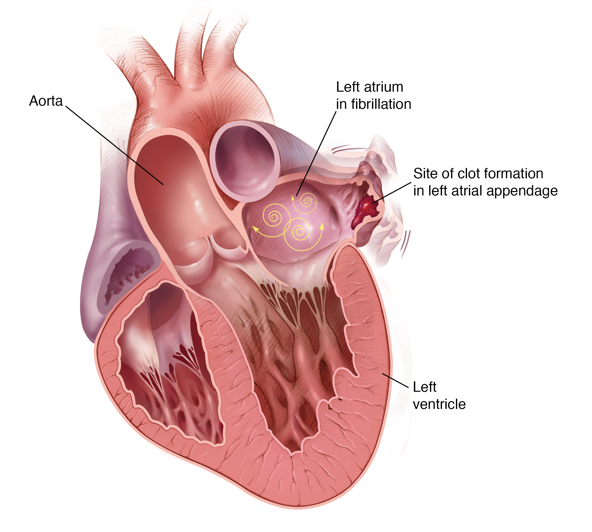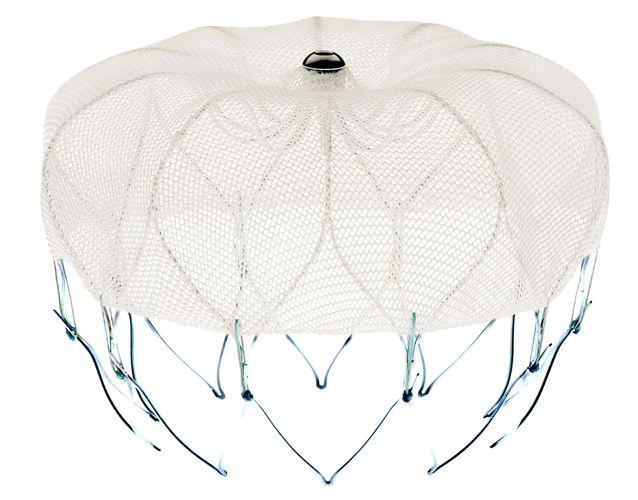
If you have AFib not caused by valve defects, you find yourself faced with a lifelong need for blood thinners so as to reduce the risk of strokes. Taking these drugs requires that you live with food and drink restrictions and submit to regular blood tests. If you are at risk for bleeding or have a history of doing so, the new WATCHMAN permanent heart implant may offer you protection without reliance on prescription drugs which can often result in bleeding after long term use. Within 45 days of the Watchman procedure, 9 of 10 people In clinical trials who use blood thinners such as warfarin (often sold under the brand name of Coumadin®) can safely stop taking them.


Atrial Fibrillation (or AFib) decreases the ability of the heart to pump blood by up to 30%. The result of this abnormal pumping pattern is that blood cells can clot or stick together in the left arterial appendage (LAA). If a blood clot escapes from the LAA, it can travel elsewhere in your body and block the blood supply to the brain, which results in a stroke. Someone suffering from AFib or AF is 5 times as likely to have a stroke as a person with a regular heartbeat. More than 90% of clots that lead to strokes in those with atrial fibrillation not caused by heart valve problems (the most common type of Afib) are formed in the LAA.

To lower the risk of strokes in those who suffer from atrial fibrillation not related to heart valve problems, taking blood thinners or anticoagulants is a daily necessity. Warfarin, the generic for brand-names such as Coumadin®, Eliquis®, Pradaxa®, Xarelto® and Savaysa®, is an anticoagulant that prevents dangerous clotting.
Taking anticoagulants can cause a new set of problems. If you have difficulty with blood clotting, a cut may take longer to heal or a bleed in the brain may pose a risk of stroke – a life-threatening situation. This requires an alternative to blood thinners, which makes the WATCHMAN implant a lifesaver for those with a history of bleeding or a lifestyle, occupation, or condition where the risk of bleeding is significant. Electrophysiologists/ Cardiologists such as Dr. Bhakta suggest the implant to reduce stroke risk.


The WATCHMAN is a permanent implant about the size of a quarter that it is made from lightcompact materials commonly used for medical implants. Once installed, it offers an alternative to the lifelong use of blood thinners.


WATCHMAN effectively reduces the risk of stroke by permanently closing off the LAA to keep blood clots from escaping. WATCHMAN can eliminate the bleeding risks and regular blood tests and food-and-drink restrictions that come with warfarin. In a clinical trial, 9 out of 10 people were able to stop taking warfarin just 45 days after the WATCHMAN procedure.


WATCHMAN is implanted into your heart in a one-time procedure. To implant WATCHMAN, your doctor makes a small cut in your upper leg and inserts a narrow tube, as done in a standard stent procedure. Your doctor then guides WATCHMAN into your heart’s LAA. The procedure is done under general anesthesia and takes about an hour. Patients commonly stay in the hospital overnight and leave the next day.


Following the WATCHMAN procedure, you’ll take warfarin for 45 days or until your LAA is permanently closed off. During this time, heart tissue will grow over the implant to form a barrier against blood clots. Your doctor will monitor this process by taking pictures of your heart to see when you can stop taking warfarin. Your doctor will then prescribe a medicine called clopidogrel (also known as Plavix®) and aspirin for you to take for six months. After that, you’ll continue to take aspirin on an ongoing basis. A very small number of patients may need to keep taking blood thinners long term. In a clinical trial:


The WATCHMAN Device is a permanent implant designed to close the left atrial appendage in the heart in an effort to reduce the risk of stroke. With all medical procedures there are risks associated with the implant procedure and the use of the device. The risks include but are not limited to accidental heart puncture, air embolism, allergic reaction, anemia, anesthesia risks, arrhythmias, AV (Arteriovenous) fistula, bleeding or throat pain from the TEE (Trans Esophageal Echo) probe, blood clot or air bubbles in the lungs or other organs, bruising at the catheter insertion site, clot formation on the WATCHMAN™ Closure Device, cranial bleed, excessive bleeding, gastrointestinal bleeding, groin puncture bleed, hypotension, infection/pneumonia, pneumothorax, pulmonary edema, pulmonary vein obstruction, renal failure, stroke, thrombosis and transient ischemic attack. In rare cases death can occur. Be sure to talk with your doctor so that you thoroughly understand all of the risks and benefits associated with the implantation of the WATCHMAN Device.